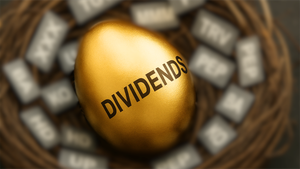
A major ripple effect of the SVB Financial collapse is lower bond yields.
With the Federal Reserve vowing higher interest rates for longer, the 10-year Treasury Note yield entered March like a lion roaring above 4% for the first time since November 2022. After finishing last week at 3.4%, it appears to be heading out like a lamb.
The cash payout pool was significantly drained for income investors that favor corporate bonds and dividend-paying stocks. One of the most reliable income generators — bank stocks — have become vulnerable if not untouchable. Yes, their yields are much higher, but so are their inherent risks.
This has financial sector investors in search of high-yielding equity alternatives. Consumer staples, utilities and energy names are viable options but often come with limited price appreciation.
Enter technology.
Huh?
Not known for big dividend payments, tech companies that have suffered SVB-like declines over the past year now offer some of the market’s highest yields.
Granted, these tend to be ‘old school’ tech names that rely on legacy technologies and operate in mature industries. But what they lack in exposure to high-growth markets, they can make up for with stability — and generous dividends.
The average yield among financial stocks is around 3.2%. These five tech companies are yielding much more.
1) IBM
International Business Machines Co. (NYSE: IBM) is no longer the hot investment it was in the late 1990’s. One thing that hasn’t wavered, however, is the company’s commitment to raising dividends. When IBM bumped its quarterly dividend to $1.65 last spring, it marked the 27th straight year of dividend increases.
And while the pace of the increases has slowed in recent years, the prioritization of this dividend policy is an attractive attribute. The forward dividend yield of 5.3% isn’t too shabby either.
2) Hewlett Packard
Staying in the personal computing space, HP Inc. (NYSE: HPQ) has grown its annual dividend above $1.00 following 13 consecutive years of dividend hikes. Its 3.7% forward yield isn’t as juicy as that of IBM, but a low 29% payout ratio is a big plus. It means that a relatively small portion of company earnings are being returned to shareholders as dividends.
This not only makes for a more stable dividend but one that has ample capacity for future increases. Another positive — HP’s dividend growth rate accelerated to 29% last year, signaling management’s confidence in a PC market recovery.
3) Dell
Dell Technologies, Inc. (NYSE: DELL) is another stock that could benefit from a PC market rebound. Although it doesn’t have the decorated dividend growth track record of an IBM or HP, it does have a low 28% payout ratio that sets the stage for future growth. Dell’s $1.48 annual dividend payout translates to a 4.0% forward yield.
Since spinning off VWWare in November 2021, Dell has become a more focused company which, along with better cost management, allowed it to grow profits 23% last year. Shades of the Dell of yesteryear. A growing infrastructure business that provides servers, storage and networking solutions to enterprises stands to offset PC market cyclicality — and support dividend growth.
4) Seagate
Speaking of storage, Seagate Technology Holdings Plc (NASDAQ: STX) has long sported one of the tech sector’s highest yields. Despite the tough macroeconomic backdrop, the hard disk drive (HDD) specialist is sticking with its dividend policy even as it hits the brakes on share repurchases. Seagate’s dividend increased 2%, 3% and 4% over the last three years bringing the current annual payout to 4.6%.
Plenty of challenges remain including customer inventory gluts, weaker consumer spending and soft China demand. Longer-term, however, exposure to PCs, consumer electronics and enterprise storage should make for a more sustainable dividend.
5) Xerox
At the high end of the risk spectrum, Xerox Holdings Corporation (NYSE: XRX) pays a $1.00 per share annual dividend which equates to a 6.8% forward yield. Besides lacking a dividend hike history and having a 60% payout ratio, Xerox’s yield is as high as it is for good reason. The company is trying to stay relevant in the digital age by diversifying away from its legacy printer and copier business. The post-pandemic shift to hybrid work environments also poses a threat and has Xerox shifting to software and services that support remote workforces.
Unproven in both arenas, this is why the stock is still languishing near March 2020 Covid lows. Investors that are willing to bet on a successful transition to remote work solutions and Xerox’s investments in 3D printing, artificial intelligence (AI) and robotic automation could be in for some significant income and price appreciation.





